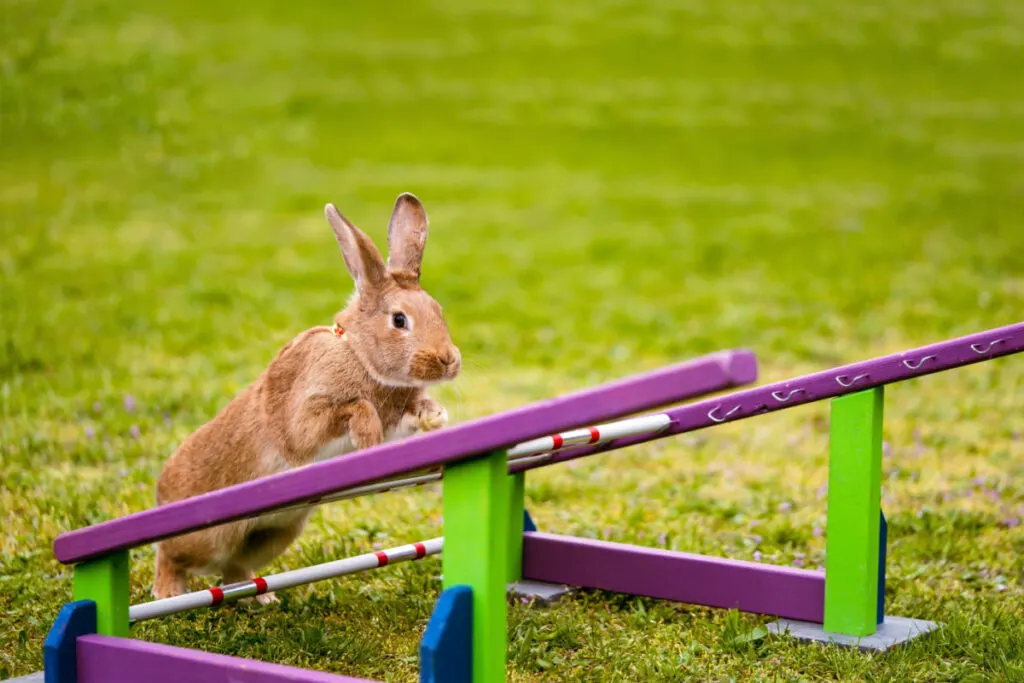If you’ve owned a rabbit before, or currently own one, you probably know how these animals positively affect your mental health. Because they have helped you through a lot of difficult times, you might be wondering, can a rabbit be a service animal?
Table of Contents
Can a rabbit be a service animal?
Rabbits are not legally acknowledged as service animals. However, they can be Emotional Support Animals (ESA) for individuals who are suffering from mental health conditions.
Rabbits can be prescribed as an ESA by a psychologist, or a mental health professional as a type of treatment. Rabbits can also be registered as therapy animals to certify that they assist in relieving a person’s mental health condition.

What is an Emotional Support Animal?
An Emotional Support Animal (ESA) is an animal that is capable of giving comfort to an individual who is experiencing negative emotional and mental health conditions.
Dogs are most commonly used as ESAs. However, other animals can also be certified as an ESA as long as they are able to help their owner, or caretaker, who is currently struggling with mental health. Moreover, the animal does not need to be trained to be an ESA.
What matters is the bond created between the animal and the person who needs mental health support.
Meaning, if you are currently suffering from mental health issues, such as depression or anxiety, and your rabbit is able to alleviate the negative impacts of the condition, then you can get your rabbit certified as an ESA.
What is the benefit of having your pet rabbit certified as an ESA?
Having your rabbit certified as an ESA will help you to easily travel, or find a house without having the need to be separated from your pet. It is still necessary to know the laws and requirements surrounding ESAs in your area so that you are ready for whatever circumstances may arise.
What are the differences between an Emotional Support Animal, a therapy animal, and a service animal?
Most people think that a service animal is similar to an Emotional Support Animal, a therapy animal, or vice versa. However, the three are distinct classifications that require different standards for an animal to be included in one of these designations.
Therapy animals are different from ESAs since the former needs to be trained to be gentle and easy-going around people. Therapy animals are mostly used to give emotional support to children, or patients, who are in therapy sessions. Meaning, they are not kept as pets of the person being treated.
Aside from undergoing training, therapy animals also have to be registered with a therapy animal organization before they can come to a hospital or any psychological facility to provide emotional support.
Rabbits are capable of being therapy animals, provided that they meet the specific criteria and standards set by the organization they are to be certified with.
The criteria may vary, but in general, they should be:
- warm and friendly around people
- healthy and well taken care of
- regularly groomed
- capable of easily adjusting in unfamiliar environments
- able to wear a leash or a harness
- should be litter trained
On the other hand, a service animal should be trained for specific functions to support Persons With Disabilities (PWDs). For example, they should be trained to push the wheelchair of their owner, or as a guide dog for people who are visually impaired.
Because they have critical roles in the community, service animals are more protected by the law. Currently, only dogs can be certified as service animals, which means that a rabbit cannot be a certified service animal.

7 Reasons to Get an Emotional Support Rabbit
Although cats and dogs are the most commonly used ESAs, any domesticated animals, including rabbits, can be an ESA to their owner. Rabbits make excellent ESAs for various reasons, and here are some of the reasons why:
1. Rabbits are calm and affectionate
Rabbits are wonderful ESAs simply because they have loving, gentle, and docile temperaments.
These fuzzy animals can easily create strong bonds with their owners, and their caring attitude makes them excellent companions.
Those rabbits that have already created a strong bond with their owners can even recognize their owner’s voice and will come when their name is called.
Rabbits are also affectionate animals who enjoy being cuddled. They thrive on physical contact, although you need to be careful when touching them since they prefer gentle handling. Most rabbits will be comfortable sitting beside their owners while being cuddled.
2. Rabbits do not need a lot of space
If you live in a house with a small space, such as an apartment, a rabbit will be an excellent choice as an ESA. Medium or large animals, such as dogs, may need a backyard where they can run and use the bathroom.
But with rabbits, you will only need a small space to keep them comfortable. You don’t need to cage them, but you can have an open cage that will serve as their feeding area.
It is important to rabbit-proof your home. For example, keep any wires or cables hidden from them so they won’t be able to chew them. Or, you can also make a bunny-friendly room.
Moreover, rabbits don’t need to be taken out for walks. They are happy to stay inside the house, hopping around until they meet their daily exercise requirements.

3. Rabbits are highly trainable
Apparently, rabbits are easy to train. They will easily learn to use a litter box provided that they are given a bit of guidance in the beginning. Therefore, you won’t need to clean them out every day.
They are clean animals who don’t need to be given regular baths. Provided that they are litter-trained, you won’t need to worry about having a smelly house.
They are also capable of learning tricks as long as positive reinforcement techniques are used, such as food rewards.
4. Rabbits are quiet
If you’re living in an area with noise restrictions, you might not like the idea of having a dog or a cat since they give off loud noises that may disturb your neighbors.
Instead, a rabbit will be a better choice. They are very quiet animals, and the few squeaks they may make are seriously cute to hear.
5. Rabbits are inexpensive
If you visit your local animal shelter, there’s a high chance that you may find a rabbit that is available for adoption. Because they are typically smaller in size than other animals in the shelter, you may find that their adoption fee is much less.
Adopting a rabbit from the shelter requires more patience and understanding, but it is surely rewarding.
6. Rabbits are long-lived creatures
In general, a healthy rabbit has a lifespan of 10 years or more, allowing you to create a long-term relationship with them. Therefore, adopting a rabbit as an ESA should be taken very seriously because it is a long commitment you can have with these animals.

7. Rabbits have huge personalities
Rabbits have pleasurable, distinct personalities that make them capable of comforting and cheering up their owners. For this reason, they make the perfect ESAs.
They are also cute, fluffy animals with very adorable floppy ears and twitching noses. Simply watching them hop and play around your house is comforting enough.
Since rabbits are social animals, having another rabbit to keep them company is also a good way to prevent them from being stressed, or depressed.
Conclusion
Although rabbits cannot be certified as service animals, they will surely make excellent Emotional Support Animals (ESA). Keep in mind that any animal, regardless of the species, should be given proper care, time, and love for them to grow into well-behaved, loving, and gentle pets.
